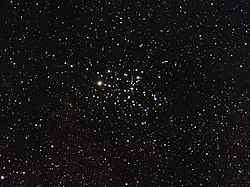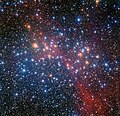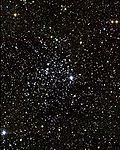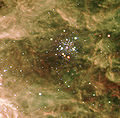The open cluster Messier 6 in the constellation Scorpius is also known as the Butterfly Cluster or NGC 6405 This is a list of open clusters located in the Milky Way . An open cluster is an association of up to a few thousand stars that all formed from the same giant molecular cloud . There are over 1,000 known open clusters in the Milky Way galaxy, but the actual total may be up to ten times higher.[ 1] half-lives of clusters, after which half the original cluster members will have been lost, range from 150 million to 800 million years, depending on the original density.[ 2]
Table
Cluster
Image
Epoch J2000
Constellation
DistanceLight-years )
AgeMyr )
Diameter
Apparent
Notes
R. A.
Dec.
Hyades
04h 26.9m
+15° 52′
Taurus
153
625
330'
0.5
[ 3]
Coma Star Cluster
12h 22.5m
+25° 51′
Coma Berenices
280
400-500
120'
1.8
[ 4]
Messier 45 (Pleiades )
03h 47.4m
+24° 07′
Taurus
444
125
120'
1.2
[ 5]
IC 2602 (Southern Pleiades/Theta Carinae Cluster)
10h 43.2m
−64° 24′
Carina
486
30
100'
1.9
[ 6]
Alpha Persei Cluster
03h 26.0m
+49° 07′
Perseus
570
50
300'
1.2
[ 7]
IC 2391 (Omicron Velorum Cluster)
08h 40.6m
−53° 02′
Vela
574
30
60'
2.5
[ 6]
NGC 2451 A
07h 45.4m
−37° 58′
Puppis
600
50
45'
2.8
[ 8] [ 9]
Messier 44 (Beehive Cluster )
08h 40.4m
+19° 41′
Cancer
610
830
70'
3.1
[ 10] [ 11]
Melotte 186
18h 01.1m
+02° 54′
Ophiuchus
652
100
240'
3.0
[ 12]
Blanco 1
00h 04.3m
−29° 56′
Sculptor
+160 100
90'
4.5
[ 6]
Messier 7 (Ptolemy's Cluster)
17h 53.8m
−34° 47′
Scorpius
980 ± 33
224
80'
3.3
[ 8] [ 13]
Messier 39 (Pyramid Cluster)
21h 31.8m
+48° 27′
Cygnus
1,010
280
30'
4.6
[ 1] [ 8]
IC 348
03h 44.6m
+32° 10′
Perseus
1,028
44
7'
7.3
[ 1]
NGC 6633
18h 27.7m
+06° 34′
Ophiuchus
1,040
660
20'
4.6
[ 14]
Pi Puppis Cluster
07h 08m
−37° 10′
Puppis
1,040.5
50'
2.1
[ 15]
NGC 2232
06h 26.4m
−04° 45′
Monoceros
1,060
53
45'
3.9
[ 1] [ 8]
Trumpler 10
08h 47.8m
−42° 29′
Vela
1,100
35
14'
4.6
[ 1] [ 8]
IC 4665 (Summer Beehive Cluster)
17h 46.3m
+05° 43′
Ophiuchus
1,120
43
70'
4.2
[ 1]
NGC 2547
08h 10.8m
−49° 18′
Vela
1,190
38
25'
4.7
[ 8]
Collinder 140
07h 24.5m
−31° 51′
Canis Major
1,226
35
42'
3.5
[ 1] [ 8]
IC 4756 (Graff's Cluster)
18h 39.0m
−05° 27′
Serpens
1,300
500
40'
4.6
[ 1] [ 8]
NGC 2516 (Southern Beehive Cluster)
07h 58.0m
−60° 48′
Carina
1,300
141
30'
3.8
[ 8] [ 13]
Lambda Orionis Cluster
05h 35m
+09° 56′
Orion
1,300
5
2.8
[ 16]
NGC 3532 (Wishing Well Cluster)
11h 06.4m
−58° 40′
Carina
1,321
316
50'
3.0
[ 8] [ 13]
Trapezium Cluster
5h 35.4m
−05° 27′
Orion
1,344 ± 20
0.3
0.783'
4.0
[ 17]
NGC 752
01h 57.7m
+37° 47′
Andromeda
1,470
1,700–2,000
75'
5.7
[ 18]
Messier 34 (Spiral Cluster)
02h 42.1m
+42° 46′
Perseus
1,500
180
36'
5.2
[ 1] [ 13]
Messier 6 (Butterfly Cluster )
17h 40.1m
−32° 13′
Scorpius
1,590
94
20'
4.2
[ 1]
Messier 47
07h 36.6m
−14° 30′
Puppis
1,600
73
25'
4.4
[ 1]
NGC 6281 (Moth Wing Cluster)
17h 04.7m
−37° 59′
Scorpius
1,611
220
8'
5.4
[ 1]
Messier 25
18h 31.7m
−19° 07′
Sagittarius
2,000
92
30'
4.6
[ 1]
Messier 23
17h 57.0m
−18° 59′
Sagittarius
2,050
300
30'
5.5
[ 1] [ 13]
Messier 41
06h 46.0m
−20° 46′
Canis Major
2,360
240
40'
4.5
[ 1] [ 13]
Messier 48
08h 13.7m
−05° 45′
Hydra
2,500
400
30'
5.8
[ 1]
Messier 67 (King Cobra Cluster/Golden Eye Cluster)
08h 51.3m
+11° 48′
Cancer
2,610 – 2,930
4,000
25'
6.9
[ 1] [ 13]
Messier 50 (Heart-shaped Cluster)
07h 02.6m
−08° 23′
Monoceros
2,870
130
14'
5.9
[ 19]
Messier 35 (Shoe-Buckle Cluster)
06h 09.1m
+24° 21′
Gemini
2,970
180
25'
5.0
[ 19]
Messier 93 (Critter Cluster)
07h 44.6m
−23° 52′
Puppis
3,380
390
10'
6.2
[ 1]
Messier 38 (Starfish Cluster)
05h 28.7m
+35° 51′
Auriga
3,480
316
20'
6.4
[ 1]
Collinder 121
07h 08m
−37° 10′
Canis Major
3,590 ± 0.72
50'
2.6
[ 20]
Messier 21 (Webb's Cross)
18h 04.2m
−22° 29′
Sagittarius
3,930
12
14'
5.9
[ 1]
Messier 18 (Black Swan Cluster)
18h 20.0m
−17° 06′
Sagittarius
4,230
17
5'
6.9
[ 1]
Messier 36 (Pinwheel Cluster)
05h 36.2m
+34° 08′
Auriga
4,340 ± 0.87
25
10'
6.0
[ 1]
Messier 37 (Salt and Pepper Cluster)
05h 52.3m
+32° 33′
Auriga
4,500
347
14'
5.6
[ 1]
Messier 52 (Scorpion Cluster)
23h 24.8m
+61° 35′
Cassiopeia
4,600
160
15
6.9
[ 1]
Messier 46
07h 41.7m
−14° 49′
Puppis
4,920 ± 980
250
20'
6.1
[ 1]
Messier 26
18h 45.3m
−09° 23′
Scutum
5,160
85
7'
8.0
[ 1]
Messier 16 (Eagle Nebula )
18h 18.8m
−13° 49′
Serpens
5,700 ± 400
1.3
6'
6.0
[ 1]
Messier 11 (Wild Duck Cluster )
18h 51.1m
−06° 16′
Scutum
6,120
250
13'
5.8
[ 1] [ 13] [ 21]
Messier 103
01h 33.4m
+60° 39′
Cassiopeia
9,400
16
5'
7.4
[ 22]
Messier 24 (Small Sagittarius Star Cloud)
18h 17.0m
−18° 29′
Sagittarius
10,000
220
90'
2.5
[ 1] [ 13]
Arp-Madore 2
07h 38.8m
−33° 51′
Puppis
30,000
5,000
1.3'
[ 23]
NGC 2070
05h 38.7m
−69° 06′
Dorado
157,000
1.5
3.5'
7.25
[ 24] [ 25]
Hodge 301
05h 38.5m
−69° 04′
Dorado
168,000
25
0.5'
11
[ 26] [ 27]
Collinder 261
12h 38.0m
−68° 22′
Musca
2,500
8,000
9'
10.7
[ 28] [ 29]
NGC 225
00h 43.6m
+61° 46′
Cassiopeia
657
130
12'
7.0
[ 1]
NGC 5662
14h 35.6m
−56° 37′
Centaurus
666
70
30'
5.5
[ 1] [ 13]
NGC 5460
14h 07.4m
−48° 20′
Centaurus
678
160
36'
5.6
[ 1] [ 13]
NGC 189
00h 39.7m
+61° 04′
Cassiopeia
752
10
3.7'
8.8
[ 1]
NGC 6025
16h 03.3m
−60° 26′
Triangulum Australe
756
130
14'
5.1
[ 1] [ 13]
IC 5146
21h 53.5m
+47° 16′
Cygnus
852
1
9'
7.2
[ 1]
NGC 2301
06h 51.75m
+00° 28′
Monoceros
858
165
12'
6.0
[ 30]
IC 4651
17h 24.8m
−49° 56′
Ara
888
1,900
10'
6.9
[ 1] [ 13]
NGC 6087 , S Normae Cluster
16h 18.8m
−57° 56′
Norma
891
70
14'
5.4
[ 1] [ 13]
NGC 3114
10h 02.7m
−60° 07′
Carina
911
124
36'
4.2
[ 1]
NGC 2509
08h 00.7m
−19° 04′
Puppis
912
Uncertain[ 31]
10'
9.3
[ 32]
NGC 2264
06h 41.0m
+09° 53′
Monoceros
913
1.5
40'
3.9
[ 33]
NGC 1502
04h 07.8m
+62° 20′
Camelopardalis
1,000
10
8'
5.7
[ 1]
Berkeley 59
00h 04.0m
+68° 35′
Cepheus
1,000
2
180'
[ 34]
NGC 2169
06h 08.4m
+13° 58′
Orion
1,052
12
5'
5.9
[ 1]
NGC 6242
16h 55.6m
−39° 28′
Scorpius
1,131
50
9'
6.4
[ 1] [ 13]
NGC 381
01h 08.3m
+61° 35′
Cassiopeia
1,148
320
7'
9.3
[ 1]
NGC 6204
16h 46.1m
−47° 01′
Ara
1,200
79
6'
8.2
[ 1]
NGC 6231
16h 54.1m
−41° 50′
Scorpius
1,243
6
14'
2.6
[ 1] [ 13]
NGC 2439
07h 40.8m
−31° 41′
Puppis
1,300
25
9'
6.9
[ 1] [ 13]
NGC 6067
16h 13.2m
−54° 13′
Norma
1,417
170
14'
5.6
[ 1] [ 13]
NGC 2362 , Tau Canis Majoris Cluster
07h 18.6m
−24° 59′
Canis Major
1,480
4–5
5'
4.1
[ 35]
NGC 6756
19h 08.7m
+04° 42′
Aquila
1,507
62
4'
4.5
[ 1]
NGC 6031
16h 07.9m
−54° 03′
Norma
1,510
117
3'
8.5
[ 1] [ 36]
NGC 2175
06h 09.7m
+20° 29′
Orion
1,627
8.9
5'
6.8
[ 1]
NGC 188
00h 48.4m
+85° 15′
Cepheus
1,660
6,600
17'
8.1
[ 13] [ 37]
NGC 2244
06h 31.9m
+04° 56′
Monoceros
1,660
1.9
30'
4.8
[ 1]
NGC 129
00h 30.0m
+60° 13′
Cassiopeia
1,670
76
21′
6.5
[ 38]
NGC 2360 , Caroline's Cluster
07h 17.7m
−15° 38′
Canis Major
1,887
1,000
13'
7.2
[ 1] [ 13]
NGC 6834
19h 52.2m
+29° 25′
Cygnus
1,930
76
5'
7.8
[ 1] [ 36]
NGC 659
01h 44.4m
+60° 40′
Cassiopeia
1,938
35
5'
7.9
[ 1]
NGC 4755, Jewel Box
12h 53.6m
−60° 22′
Crux
1,976
14
10'
4.2
[ 1] [ 13]
NGC 6200
16h 44.1m
−47° 28′
Ara
2,056
8.5
12'
7.4
[ 39]
NGC 869
02h 19.1m
+57° 09′
Perseus
2,079
12
18'
3.7
[ 1]
NGC 637
01h 43.0m
+64° 02′
Cassiopeia
2,160
10
4.2'
8.2
[ 1]
NGC 2355
07h 17.0m
+13° 47′
Gemini
2,200
955
5'
9.7
[ 1] [ 13]
NGC 2129
06h 01.1m
+23° 19′
Gemini
2,200
10
5'
6.7
[ 1] [ 40]
NGC 663
01h 46.1m
+61° 14′
Cassiopeia
2,420
25
14'
7.1
[ 1]
NGC 457
01h 19.1m
+58° 17′
Cassiopeia
2,429
21
20'
6.4
[ 41]
NGC 2204
06h 15.5m
−18° 40′
Canis Major
2,629
787
13'
8.6
[ 1]
NGC 884
02h 22.0m
+57° 08′
Perseus
2,940
14
18'
3.8
[ 1] [ 13]
NGC 1931
05h 31.0m
+34° 15′
Auriga
3,086
10
3'
10.1
[ 1]
NGC 1980
5h 25.43m
−05° 54′
Orion
550
4.7
14'
2.5
[ 42]
NGC 2158
06h 07.4m
+24° 06′
Gemini
5,071
1,054
5'
8.6
[ 1]
Teutsch 2
05h 41.4m
+39° 14′
Auriga
5,700
900
2'
11
[ 43]
NGC 6791
19h 20.9m
+37° 46′
Lyra
5,853
8,900
16'
9.5
[ 1] [ 13]
NGC 3293
10h 35.8m
−58° 13′
Carina
2,750
8
8'
4.7
NGC 3766 , Pearl Cluster
11h 36.2m
−61° 37′
Centaurus
1745
14
12'
5.3
NGC 7419
22h 54.3m
+60° 48.9′
Cepheus
2,800
2'
13
NGC 7789 , White Rose Cluster
23h 57.4m
+56° 43′
Cassiopeia
2,337
1,700
16'
6.7
[ 44]
Gaia 1
06h 45.9m
−16° 45′
Canis Major
4,600
6,300
13'
8.3
Ru 7
06h 58.9m
−13° 15′
Canis Major
[citation needed
See also
References
^ a b c d e f g h i j k l m n o p q r s t u v w x y z aa ab ac ad ae af ag ah ai aj ak al am an ao ap aq ar as at au av aw ax ay az ba bb bc bd be bf bg bh bi bj bk bl Dias W.S.; Alessi B.S.; Moitinho A.; Lepine J.R.D. (July 2002). "New catalog of optically visible open clusters and candidates". Astronomy and Astrophysics . 389 (3): 871– 873. arXiv :astro-ph/0203351 Bibcode :2002A&A...389..871D . doi :10.1051/0004-6361:20020668 . S2CID 18502004 . VizieR catalogue B/ocl .^ de La Fuente, M. R. (1998). "Dynamical Evolution of Open Star Clusters" . Publications of the Astronomical Society of the Pacific . 110 (751): 1117. Bibcode :1998PASP..110.1117D . doi :10.1086/316220 ^ Perryman, M.A.C.; et al. (1998). "The Hyades: distance, structure, dynamics, and age". Astronomy & Astrophysics . 331 : 81– 120. arXiv :astro-ph/9707253 Bibcode :1998A&A...331...81P . ^ Casewell, S. L.; Jameson, R. F.; Dobbie, P. D. (January 2006). "New stellar members of the Coma Berenices open star cluster" . Monthly Notices of the Royal Astronomical Society 365 (2): 447– 453. arXiv :astro-ph/0510133 Bibcode :2006MNRAS.365..447C . doi :10.1111/j.1365-2966.2005.09689.x ^ Percival, S. M.; Salaris, M.; Groenewegen, M. A. T. (2005). "The distance to the Pleiades. Main sequence fitting in the near infrared". Astronomy and Astrophysics . 429 (3): 887– 894. arXiv :astro-ph/0409362 Bibcode :2005A&A...429..887P . doi :10.1051/0004-6361:20041694 . S2CID 14842664 . ^ a b c Mermilliod, J.-C.; Turon, C.; Robichon, N.; Arenou, F.; Lebreton, Y. (May 13–16, 1997). "The Distance of the Pleiades and Nearby Clusters". Proceedings of the ESA Symposium 'Hipparcos - Venice '97' . Venice, Italy: ESA. Bibcode :1997ESASP.402..643M . ^ Basri, Gibor; Martín, Eduardo L. (January 1999). "The Mass and Age of Very Low Mass Members of the Open Cluster alpha Persei". The Astrophysical Journal . 510 (1): 266– 273. arXiv :astro-ph/9807145 Bibcode :1999ApJ...510..266B . doi :10.1086/306564 . S2CID 2562718 . ^ a b c d e f g h i j Robichon, N.; et al. (2005). "Open clusters with Hipparcos. I. Mean astrometric parameters". Astronomy and Astrophysics . 345 : 471– 484. arXiv :astro-ph/9903131 Bibcode :1999A&A...345..471R . ^ Hünsch, M.; Weidner, C. & Schmitt, J. H. M. M. (May 2003). "An X-ray study of the open clusters NGC 2451 A and B" . Astronomy and Astrophysics . 402 (2): 571– 586. Bibcode :2003A&A...402..571H . doi :10.1051/0004-6361:20030268 ^ Pinfield, D. J.; et al. (July 2003). "Brown dwarfs and low-mass stars in the Pleiades and Praesepe: membership and binarity" . Monthly Notices of the Royal Astronomical Society . 342 (4): 1241– 1259. arXiv :astro-ph/0303600 Bibcode :2003MNRAS.342.1241P . doi :10.1046/j.1365-8711.2003.06630.x S2CID 285922 . ^ "NGC 2632" . sim-id . Retrieved 2020-06-11 .^ "Cl Melotte 186" . sim-id . Retrieved 2020-07-13 .^ a b c d e f g h i j k l m n o p q r s t u v w x Meynet, G.; Mermilliod, J.-C.; Maeder, A. (May 1993). "New dating of galactic open clusters". Astronomy and Astrophysics Supplement Series . 98 (3): 477– 504. Bibcode :1993A&AS...98..477M . ^ van Leeuwen, F. (February 2013), "Parallaxes and proper motions for 20 open clusters as based on the new Hipparcos catalogue", Astronomy and Astrophysics , 497 (1): 209– 242, arXiv :0902.1039 Bibcode :2009A&A...497..209V , doi :10.1051/0004-6361/200811382 , S2CID 16420237 . ^ "Cl Collinder 135" . SIMBAD Centre de données astronomiques de Strasbourg . Retrieved 2020-06-07 .^ "Cl Collinder 69" . SIMBAD Centre de données astronomiques de Strasbourg . Retrieved 2020-06-07 .^
Reid, M. J.; et al. (2009). "Trigonometric Parallaxes of Massive Star Forming Regions: VI. Galactic Structure, Fundamental Parameters and Non-Circular Motions". Astrophysical Journal 700 (1): 137– 148. arXiv :0902.3913 Bibcode :2009ApJ...700..137R . doi :10.1088/0004-637X/700/1/137 . S2CID 11347166 .
^ Giardino, G.; et al. (October 2008). "The X-ray luminosity of solar-mass stars in the intermediate age open cluster NGC 752". Astronomy and Astrophysics . 490 (1): 113– 123. arXiv :0808.3451 Bibcode :2008A&A...490..113G . doi :10.1051/0004-6361:200810042 . S2CID 18980057 . ^ a b Kalirai, Jasonjot Singh; Fahlman, Gregory G.; Richer, Harvey B.; Ventura, Paolo (September 2003). "The CFHT Open Star Cluster Survey. IV. Two Rich, Young Open Star Clusters: NGC 2168 (M35) and NGC 2323 (M50)". The Astronomical Journal . 126 (3): 1402– 1414. arXiv :astro-ph/0306241 Bibcode :2003AJ....126.1402K . doi :10.1086/377320 . S2CID 17018911 . ^ "Cl Collinder 121" . SIMBAD Centre de données astronomiques de Strasbourg . Retrieved 2020-06-07 .^ Paunzen, E.; Pintado, O. I.; Maitzen, H. M. (December 2003). "CCD photometric search for peculiar stars in open clusters. V. NGC 2099, NGC 3114, NGC 6204, NGC 6705 and NGC 6756". Astronomy and Astrophysics . 412 (3): 721– 725. arXiv :astro-ph/0310069 Bibcode :2003A&A...412..721P . doi :10.1051/0004-6361:20031065 . S2CID 6381138 . ^ Sanner, J.; et al. (September 1999). "Photometric and kinematic studies of open star clusters. I. NGC 581 (M 103)". Astronomy and Astrophysics . 349 : 448– 456. arXiv :astro-ph/9908059 Bibcode :1999A&A...349..448S . ^ Lee, Myung Gyoon (February 1997). "UBVI CCD Photometry of the Remote Old Open Cluster AM-2" . Astronomical Journal . 113 : 729– 739. Bibcode :1997AJ....113..729L . doi :10.1086/118292 ^ "NGC 2070" . SIMBAD Centre de données astronomiques de Strasbourg . Retrieved 11 August 2017 .^ Høg, E.; Fabricius, C.; Makarov, V. V.; Urban, S.; Corbin, T.; Wycoff, G.; Bastian, U.; Schwekendiek, P.; Wicenec, A. (2000). The Tycho-2 catalogue of the 2.5 million brightest stars . Vol. 355. pp. L27. Bibcode :2000A&A...355L..27H . doi :10.1888/0333750888/2862 . ISBN 978-0333750889 ^ "Hodge 301" . The Hubble Heritage Project . NASA. April 1, 1999. Retrieved 2010-03-25 .^ Grebel, Eva K.; Chu, You-Hua (February 2000). "Hubble Space Telescope Photometry of Hodge 301: An "Old" Star Cluster in 30 Doradus". The Astronomical Journal . 119 (2): 787– 799. arXiv :astro-ph/9910426 Bibcode :2000AJ....119..787G . doi :10.1086/301218 . S2CID 118590210 . ^ "Cl Collinder 261" . sim-id . Retrieved 2020-06-11 .^ Salaris, M; Weiss, A; Percival, S. M. (2004). "The age of the oldest Open Clusters" (PDF) . Astronomy & Astrophysics : 165– 167. ^ "SIMBAD Astronomical Database" . Results for NGC 2301 . Retrieved 2019-04-30 .^ Carraro, G.; Costa, E. (March 2007). "Photometry of the five marginally studied open clusters Collinder 74, Berkeley 27, Haffner 8, NGC 2509, and VdB-Hagen 4". Astronomy and Astrophysics . 464 (2): 573– 580. arXiv :astro-ph/0611705 Bibcode :2007A&A...464..573C . doi :10.1051/0004-6361:20066350 . S2CID 1419651 . ^ Sujatha, S.; Babu, G. S. D. (2003). "Study of open cluster NGC 2509". Bulletin of the Astronomical Society of India . 31 : 9– 18. Bibcode :2003BASI...31....9S . ^ Baxter, Eric J.; et al. (September 2009), "The Distance to NGC 2264", The Astronomical Journal , 138 (3): 963– 974, arXiv :0907.3139 Bibcode :2009AJ....138..963B , doi :10.1088/0004-6256/138/3/963 , S2CID 7940517 . ^ Pandey, A. K.; et al. (January 2008). "Stellar contents and star formation in the young star cluster Be 59" . Monthly Notices of the Royal Astronomical Society . 383 (3): 1241– 1258. arXiv :0710.5429 Bibcode :2008MNRAS.383.1241P . doi :10.1111/j.1365-2966.2007.12641.x S2CID 6776240 . ^ Currie, Thayne; et al. (June 2009). "The Last Gasp of Gas Giant Planet Formation: A Spitzer Study of the 5 Myr Old Cluster NGC 2362". The Astrophysical Journal . 698 (1): 1– 27. arXiv :0903.2666 Bibcode :2009ApJ...698....1C . doi :10.1088/0004-637X/698/1/1 . S2CID 9207187 . ^ a b Paunzen, E.; et al. (July 2006). "CCD photometric search for peculiar stars in open clusters. VII. Berkeley 11, Berkeley 94, Haffner 15, Lyngå 1, NGC 6031, NGC 6405, NGC 6834 and Ruprecht 130". Astronomy and Astrophysics . 454 (1): 171– 178. arXiv :astro-ph/0602567 Bibcode :2006A&A...454..171P . doi :10.1051/0004-6361:20054628 . S2CID 5131254 . ^ Bonatto, C.; Bica, E.; Santos, J. F. C. Jr. (April 2005). "Spatial dependence of 2MASS luminosity and mass functions in the old open cluster NGC 188". Astronomy and Astrophysics . 433 (3): 917– 929. arXiv :astro-ph/0502453 Bibcode :2005A&A...433..917B . doi :10.1051/0004-6361:20041113 . S2CID 5134042 . ^ Turner, David G.; et al. (September 1992). "Galactic clusters with associated Cepheid variables. II - NGC 129 and DL Cassiopeiae" . Astronomical Journal . 104 (3): 1132– 1143. Bibcode :1992AJ....104.1132T . doi :10.1086/116302 . ^ "open cluster NGC 6200" . WEBDA . Universität Wien. Retrieved 2011-10-28 .^ Carraro, Giovanni; Chaboyer, Brian; Perencevich, James (January 2006). "The young open cluster NGC 2129" . Monthly Notices of the Royal Astronomical Society . 365 (8): 867– 873. arXiv :astro-ph/0510573 Bibcode :2006MNRAS.365..867C . doi :10.1111/j.1365-2966.2005.09762.x S2CID 15621721 . ^ Frinchaboy, Peter M.; et al. (2008). "Open Clusters as Galactic Disk Tracers. I. Project Motivation, Cluster Membership, and Bulk Three-Dimensional Kinematics". The Astronomical Journal . 136 (1): 118– 145. arXiv :0804.4630 Bibcode :2008AJ....136..118F . doi :10.1088/0004-6256/136/1/118 . S2CID 16641439 . ^ "The open cluster NGC 1980" . In the Sky . Retrieved 27 November 2017 .^ Bonatto, C.; Bica, E. (22 October 2010). "The wide variety of evolutionary stages among 34 unstudied Teutsch open clusters" . Astronomy and Astrophysics . 521 : A74. Bibcode :2010A&A...521A..74B . doi :10.1051/0004-6361/201015222 hdl :10183/99276 ^ Kharchenko, N. V; Piskunov, A. E; Röser, S; Schilbach, E; Scholz, R.-D (2005). "Astrophysical parameters of Galactic open clusters". Astronomy and Astrophysics . 438 (3): 1163– 1173. arXiv :astro-ph/0501674 Bibcode :2005A&A...438.1163K . doi :10.1051/0004-6361:20042523 . S2CID 9079873 .
Bound Unbound Visual grouping































































